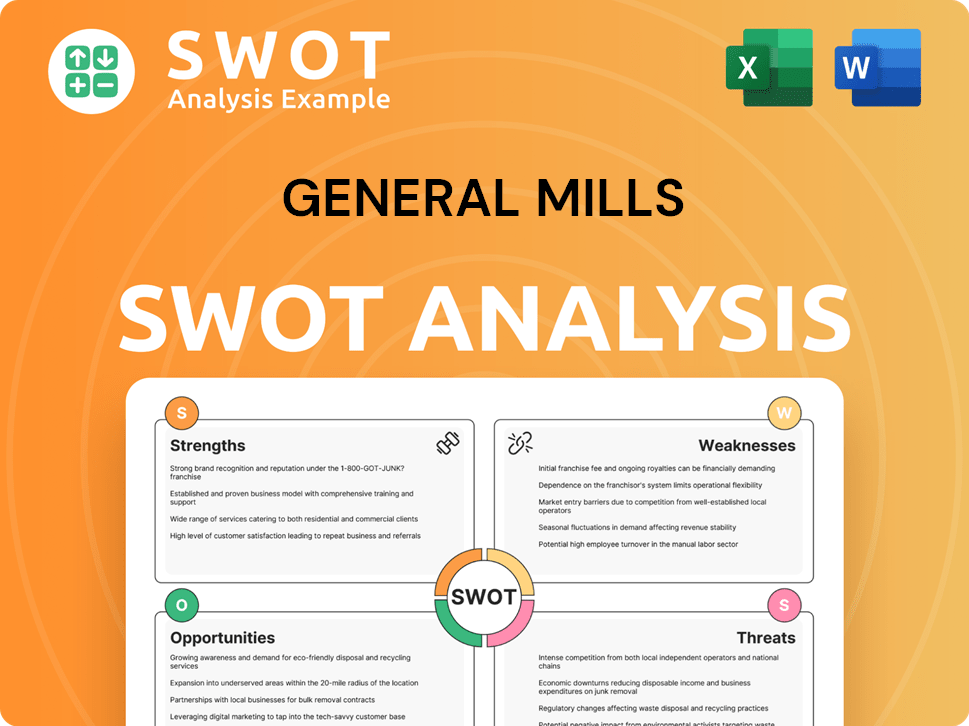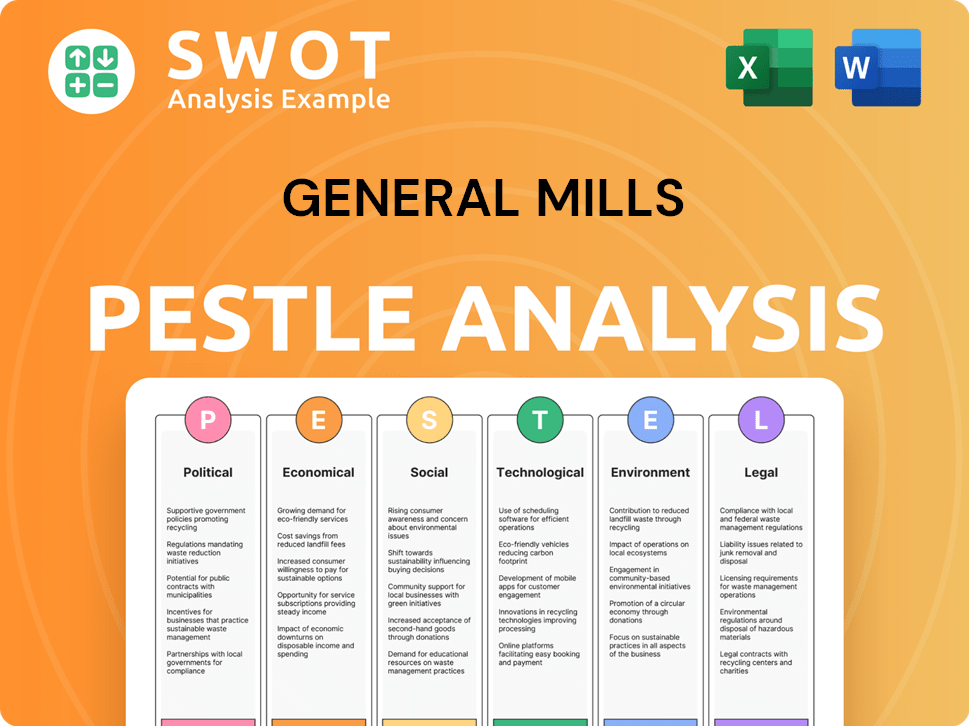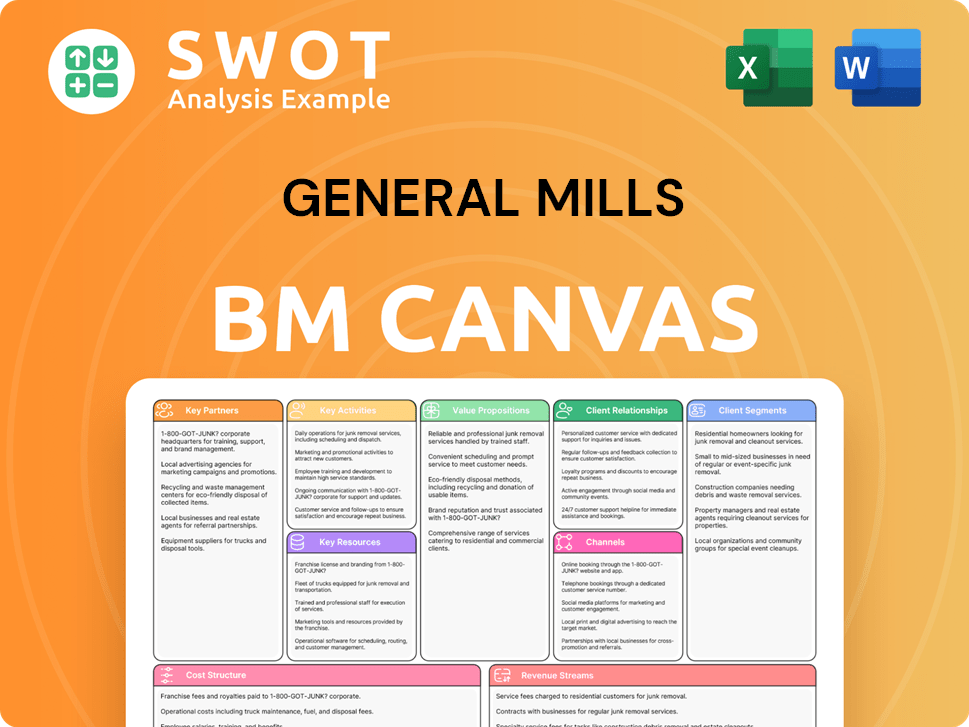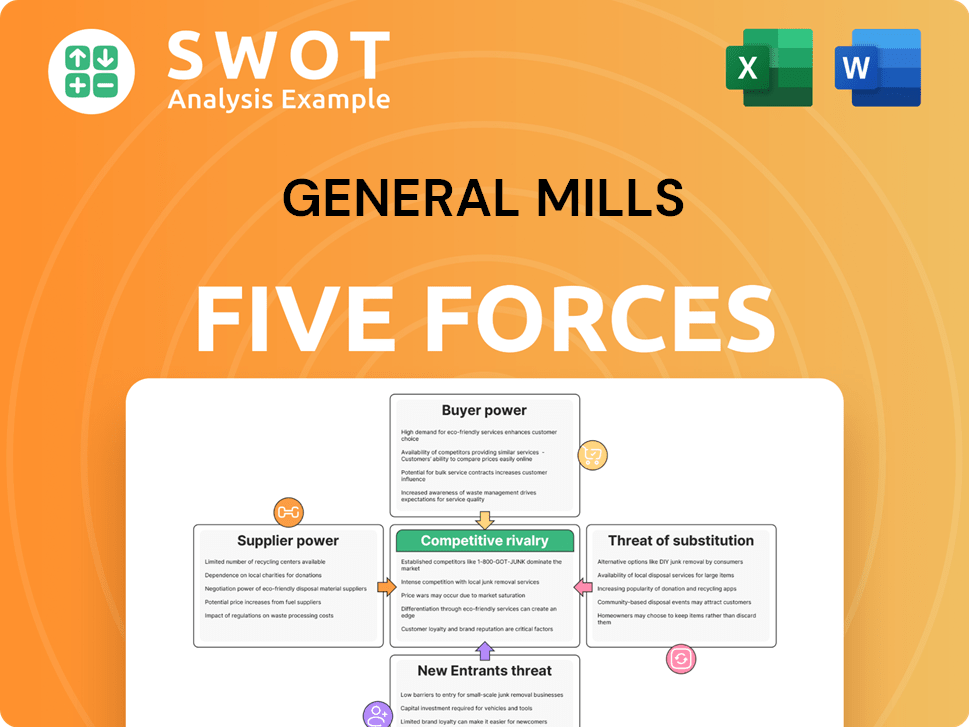General Mills Bundle
How Does General Mills Thrive in a Cutthroat Market?
General Mills, a titan in the global food industry, faces a constantly shifting competitive landscape. Recent strategic moves, like the focus on its North America Retail segment, highlight the pressure to adapt and innovate. This deep dive explores the intense rivalry within the packaged food sector, examining how General Mills navigates this dynamic environment.

Founded in 1928, General Mills has evolved from milling operations to a diversified food manufacturer. Understanding the General Mills SWOT Analysis is crucial to grasping its competitive advantages. This analysis will identify General Mills' main rivals and dissect the core differentiators that sustain its position in the food industry competition and consumer packaged goods market.
Where Does General Mills’ Stand in the Current Market?
The company maintains a strong market position across various food categories, benefiting from its extensive portfolio of well-known brands. In the third quarter of fiscal year 2024, the company demonstrated solid financial results, with net sales reaching $5.1 billion, a 2% increase on a constant-currency basis. This growth reflects the company's ability to navigate the competitive landscape and maintain consumer loyalty.
The company's core operations revolve around the production and distribution of a wide range of food products, including cereals, baking mixes, yogurt, and snacks. Its value proposition lies in offering convenient, high-quality food options that cater to diverse consumer preferences and dietary needs. The company's focus on innovation and strategic acquisitions, such as Blue Buffalo, further strengthens its market position.
The company's global presence, spanning North America, Europe, Asia, and Latin America, highlights its ability to adapt to different market dynamics and consumer tastes. The company's financial health is robust, as evidenced by its consistent net sales and adjusted diluted earnings per share, which increased by 13% to $1.17 in the third quarter of fiscal year 2024. This financial performance underscores the company's resilience and its capacity to generate value for shareholders.
The company holds leading market positions in several key categories, especially in North America. Its cereal brands like Cheerios and Lucky Charms have significant market share. The company also maintains a strong presence in the snack and yogurt segments, contributing to its overall market dominance.
The company operates globally, with significant presence in North America, Europe, Asia, and Latin America. The North America Retail segment saw a 1% increase in net sales in the third quarter of fiscal year 2024. This broad geographic footprint allows the company to diversify its revenue streams and mitigate risks associated with regional economic fluctuations.
The company's strong brand portfolio, including Cheerios, Betty Crocker, and Nature Valley, provides a competitive advantage. These established brands enjoy high consumer recognition and loyalty. The diverse brand portfolio helps the company cater to various consumer segments and preferences, bolstering its market position.
The company's financial performance reflects its strong market position and operational efficiency. The company reported net sales of $5.1 billion in the third quarter of fiscal year 2024. The adjusted diluted earnings per share increased by 13% to $1.17, demonstrating its ability to generate profits and create shareholder value. For more details, check out the Revenue Streams & Business Model of General Mills.
The company's competitive advantages include a strong brand portfolio, extensive distribution networks, and a global presence. These strengths enable it to maintain a leading position in the food industry. The acquisition of Blue Buffalo in 2018 expanded its portfolio into the growing pet food market.
- Strong Brand Recognition: Well-known brands like Cheerios and Betty Crocker drive consumer loyalty.
- Extensive Distribution: Wide distribution networks ensure product availability.
- Global Presence: Operations in multiple regions diversify revenue streams.
- Strategic Acquisitions: Acquisitions like Blue Buffalo expand market reach.
General Mills SWOT Analysis
- Complete SWOT Breakdown
- Fully Customizable
- Editable in Excel & Word
- Professional Formatting
- Investor-Ready Format

Who Are the Main Competitors Challenging General Mills?
The General Mills competitive landscape is characterized by intense rivalry across its diverse product categories and geographic markets. The company navigates a complex environment, facing both direct and indirect competitors. A thorough General Mills market analysis reveals the strategies these competitors employ to gain market share and maintain consumer loyalty. The General Mills industry is highly competitive, with constant innovation and strategic moves shaping its dynamics.
General Mills' competitors challenge it through various strategies, including product innovation, extensive distribution networks, and aggressive marketing campaigns. The breakfast cereal aisle, for instance, is a battleground where brands constantly vie for shelf space and consumer attention. The competitive landscape is also influenced by mergers and acquisitions, which reshape the industry and create larger, more formidable rivals. Understanding these competitive dynamics is crucial for assessing General Mills' financial performance compared to competitors and its overall market position.
Key direct competitors include major multinational food conglomerates. These companies compete with General Mills across various product lines, from cereals and snacks to dairy and prepared foods. The competition is not limited to product offerings; it also extends to marketing, distribution, and pricing strategies. The food industry competition is fierce, requiring constant adaptation and innovation to stay ahead.
Kellogg Company, soon to be Kellanova and WK Kellogg Co, is a major rival in the cereal and snack bar segments. Brands like Frosted Flakes and Pop-Tarts directly compete with General Mills' offerings. Kellogg's strategies often involve product innovation and aggressive marketing to maintain and expand its market share, particularly in the breakfast category.
PepsiCo, through its Quaker Oats and Frito-Lay divisions, competes in cereals, snacks, and convenience foods. PepsiCo leverages its extensive distribution network and marketing prowess for its snack brands. The competition with General Mills includes both product and brand positioning strategies, especially in the convenience food sector.
Nestlé, a global food and beverage giant, competes across a wide spectrum, including cereals, dairy, and prepared foods. Nestlé's broad product portfolio and global presence make it a significant competitor. The competition extends to various segments, including cereals, dairy, and prepared foods, challenging General Mills' market share in multiple categories.
Kraft Heinz is a significant competitor in various packaged food categories, including meals and baking products. Kraft Heinz competes with General Mills in various packaged food categories. Their strategies often involve product innovation and acquisitions to strengthen their market position. This competition impacts General Mills' product portfolio comparison and overall market share.
In the yogurt segment, General Mills' Yoplait brand competes with offerings from companies like Danone. Danone's strong presence in the yogurt market presents a significant challenge. The competition in this segment involves product innovation, marketing, and distribution strategies to capture consumer preferences.
The pet food segment, where General Mills competes with Blue Buffalo, sees strong competition from Mars Petcare and Nestlé Purina. The pet food market is highly competitive, with significant investments in product development, marketing, and distribution. These competitors challenge General Mills' position in the pet food market.
Emerging players, particularly in the natural and organic food sectors, also pose a threat. Smaller, agile companies can quickly respond to niche consumer demands. The rise of these competitors influences General Mills' competitive strategy and requires constant adaptation. The competitive landscape also includes indirect competitors and changing consumer preferences. For a deeper dive into General Mills' strategic moves, consider exploring this detailed analysis of the company's strategies General Mills SWOT analysis.
- Private-label brands: These brands offer similar products at lower prices, putting pressure on General Mills' margins.
- Specialty food companies: These companies focus on niche markets and premium products, appealing to specific consumer segments.
- Local and regional food producers: These companies can have a strong presence in their local markets and offer unique products.
- Online retailers: Online retailers can offer a wide range of products and compete on price and convenience.
General Mills PESTLE Analysis
- Covers All 6 PESTLE Categories
- No Research Needed – Save Hours of Work
- Built by Experts, Trusted by Consultants
- Instant Download, Ready to Use
- 100% Editable, Fully Customizable

What Gives General Mills a Competitive Edge Over Its Rivals?
The competitive landscape for General Mills is shaped by its robust brand portfolio and extensive market reach. The company's success is built on a foundation of well-established brands and a wide distribution network, allowing it to maintain a strong position in the consumer packaged goods sector. Understanding the General Mills competitive landscape requires analyzing its key strengths and how it differentiates itself from competitors.
General Mills faces competition from both large multinational corporations and smaller, more specialized food companies. The General Mills industry is characterized by intense competition, with companies constantly vying for market share through product innovation, strategic acquisitions, and effective marketing. A thorough General Mills market analysis reveals the dynamics of this competitive environment.
The company's ability to navigate this competitive environment is crucial for its continued success. The Food industry competition is fierce, and General Mills must continually adapt to changing consumer preferences and market trends to maintain its competitive edge. The following sections detail the specific competitive advantages that General Mills leverages in the marketplace.
General Mills boasts a strong brand portfolio, including iconic names like Cheerios, Betty Crocker, and Pillsbury. These brands have built significant consumer trust over decades, leading to high brand recognition and loyalty. This brand strength allows for premium pricing and resilient demand.
The company's vast distribution network enables its products to reach a global audience through millions of retail outlets. This widespread availability ensures high visibility and accessibility for consumers. The efficient supply chain management supports consistent product quality.
General Mills benefits from significant economies of scale in sourcing, manufacturing, and logistics. These efficiencies allow the company to achieve competitive pricing while maintaining healthy profit margins. This advantage is crucial in a price-sensitive market.
Investment in research and development is a key advantage, driving continuous product innovation to meet changing consumer needs. The expansion of organic and natural product lines, such as Annie's, demonstrates its adaptability. This focus on innovation helps maintain relevance.
General Mills' competitive advantages are multifaceted, stemming from its brand strength, distribution capabilities, and operational efficiencies. These elements collectively contribute to its ability to compete effectively within the consumer packaged goods sector. The company's strategic focus on innovation and adaptation further strengthens its position.
- Brand Strength: Strong brand recognition and consumer loyalty across key product lines.
- Distribution Network: Extensive global reach ensuring product availability.
- Economies of Scale: Cost efficiencies in production and supply chain.
- Innovation: Continuous product development to meet evolving consumer demands.
General Mills Business Model Canvas
- Complete 9-Block Business Model Canvas
- Effortlessly Communicate Your Business Strategy
- Investor-Ready BMC Format
- 100% Editable and Customizable
- Clear and Structured Layout

What Industry Trends Are Reshaping General Mills’s Competitive Landscape?
The food industry is undergoing significant shifts, impacting the competitive landscape of companies like General Mills. These changes are driven by evolving consumer preferences, technological advancements, and global economic conditions. Understanding these trends is crucial for assessing General Mills' competitive position and future prospects.
General Mills faces both challenges and opportunities in this dynamic environment. Key risks include changing consumer tastes, increased competition, and economic volatility. Conversely, opportunities lie in innovation, expanding into emerging markets, and strategic partnerships. This analysis provides insights into the current market dynamics and potential strategies for success, including a look at Owners & Shareholders of General Mills.
Several trends are reshaping the food industry. These include the rise of e-commerce and direct-to-consumer models, and the increasing demand for healthier, more sustainable food options. Regulatory changes and global economic shifts also play a significant role in influencing market dynamics.
General Mills faces challenges from declining demand in certain product categories and increased competition. Supply chain disruptions and economic pressures, such as inflation, also pose significant hurdles. Adapting to these challenges requires strategic agility and innovation.
Growth opportunities exist in emerging markets with rising disposable incomes, and through product innovations. Strategic partnerships and a focus on functional foods and sustainable packaging can also drive growth. These avenues can enhance General Mills' competitive edge.
General Mills is deploying strategies focused on brand building, product innovation, and supply chain resilience. These efforts are aimed at adapting to the evolving competitive landscape. The company is also investing in areas like plant-based foods to meet changing consumer demands.
To navigate the changing landscape, General Mills must focus on several key areas. This includes addressing the shift toward healthier and sustainable products, optimizing supply chain efficiency, and leveraging technology for enhanced consumer engagement.
- Product Innovation: Developing new products that meet evolving consumer preferences.
- Market Expansion: Growing presence in emerging markets with high-growth potential.
- Supply Chain Resilience: Strengthening supply chains to mitigate disruptions and manage costs.
- Strategic Partnerships: Collaborating with technology companies and innovative startups.
General Mills Porter's Five Forces Analysis
- Covers All 5 Competitive Forces in Detail
- Structured for Consultants, Students, and Founders
- 100% Editable in Microsoft Word & Excel
- Instant Digital Download – Use Immediately
- Compatible with Mac & PC – Fully Unlocked

Related Blogs
- What are Mission Vision & Core Values of General Mills Company?
- What is Growth Strategy and Future Prospects of General Mills Company?
- How Does General Mills Company Work?
- What is Sales and Marketing Strategy of General Mills Company?
- What is Brief History of General Mills Company?
- Who Owns General Mills Company?
- What is Customer Demographics and Target Market of General Mills Company?
Disclaimer
All information, articles, and product details provided on this website are for general informational and educational purposes only. We do not claim any ownership over, nor do we intend to infringe upon, any trademarks, copyrights, logos, brand names, or other intellectual property mentioned or depicted on this site. Such intellectual property remains the property of its respective owners, and any references here are made solely for identification or informational purposes, without implying any affiliation, endorsement, or partnership.
We make no representations or warranties, express or implied, regarding the accuracy, completeness, or suitability of any content or products presented. Nothing on this website should be construed as legal, tax, investment, financial, medical, or other professional advice. In addition, no part of this site—including articles or product references—constitutes a solicitation, recommendation, endorsement, advertisement, or offer to buy or sell any securities, franchises, or other financial instruments, particularly in jurisdictions where such activity would be unlawful.
All content is of a general nature and may not address the specific circumstances of any individual or entity. It is not a substitute for professional advice or services. Any actions you take based on the information provided here are strictly at your own risk. You accept full responsibility for any decisions or outcomes arising from your use of this website and agree to release us from any liability in connection with your use of, or reliance upon, the content or products found herein.